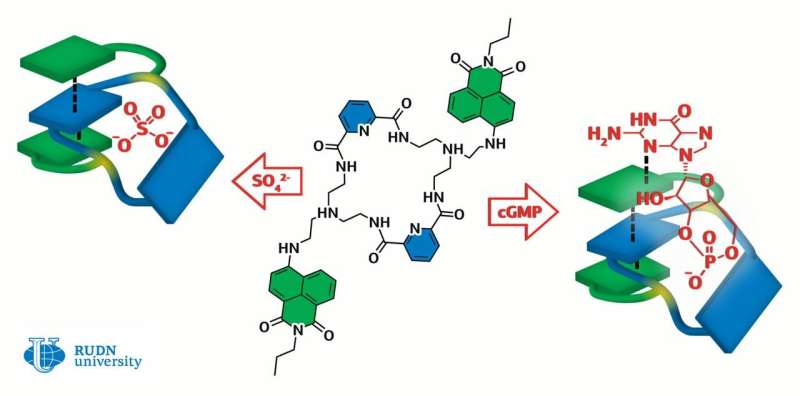Chemists create molecule that can help treat heart disease and detect viruses

RUDN University chemists together with colleagues from the Chemnitz University of Technology (Germany) have synthesized the first chemical receptor that can effectively bind to cyclic guanosine monophosphate (cGMP) in an aqueous solution—cGMP regulates many physiological processes in the cardiovascular and nervous systems. This could lead to more effective drugs for the treatment of myocardial infarction, as well as methods for detecting viruses by their nucleotides. The article is published in the Journal of Organic Chemistry.
Nucleic acids, DNA and RNA, are composed of nucleotides, or nucleoside phosphates. Free nucleotides are involved in the synthesis of chemicals in cells, affect the activity of enzymes and work as energy carriers. Therefore, to solve many medical and biotechnological problems, it is necessary to create receptors—molecules that can bind to specific types of nucleotides. This reveals which types of nucleotides are contained in the solution to better understand the mechanisms of physiological processes, as well as to create targeted drugs that selectively affect some cell functions without affecting others.
Viсtor Khrustalev, head of the Department of Inorganic Chemistry of RUDN University and his colleagues solved this problem concerning the cGMP nucleotide, cyclic guanosine monophosphate. It is a cyclic form of nucleotide formed from guanosine triphosphate (GTP). It acts as a secondary mediator and triggers a cascade of reactions that activates physiological functions in the smooth muscles of the heart, pituitary gland, retina and other cells. It is possible to affect cGMP with the help of suitable receptors, and thus, the consequences of myocardial infarction, heart hypertrophy, and heart failure can be treated.
In an aqueous solution, molecules are more difficult to bind to nucleotides. The cGMP molecule consists of a nucleotide base and a phosphate residue. To create a molecule capable of binding strongly to cGMP in an aqueous solution, the authors of the study combined a cyclic macromolecule, which due to its structure can attach to the nucleotide base of cGMP, and naphthalimide dyes, which can bind the phosphate part of cGMP.
The structure of the obtained molecule is mainly the structure of [2+2], that is, two sites of the anion-binding macromolecule and two sites with naphthalimide dyes. Biochemists also found that under conditions of high dilution of the initial substances during the creation of a new molecule, a larger macrocycle is more often formed [4 + 4].
To test the efficiency of binding the obtained molecule to cGMP, the biochemists determined and visualized the structure of the molecule using nuclear magnetic resonance spectroscopy and tested the solution by UV-visual and fluorescent titration. This method is based on a direct proportion between fluorescence and the concentration of the determined substance in solution.
The researchers also compared the structures of the obtained macromolecules with sulfate and ATP by atomic-powered microscopy. Binding studies have shown that the receptor is selective (that is, prone to bind) to cGMP.
The obtained results are the first step toward the development of selective receptors for nucleoside monophosphates, which, in the future, will allow researchers to regulate chemical processes in cells, detect viral particles in the blood, and create drugs that interact with specific areas of the cell, selectively joining with a specific nucleic acid.
More information: Aleksandr S. Oshchepkov et al. Conformational Selection in Anion Recognition: cGMP-Selective Binding by a Naphthalimide-Functionalized Amido-Amine Macrocycle, The Journal of Organic Chemistry (2019). DOI: 10.1021/acs.joc.9b00947
Provided by RUDN University




















